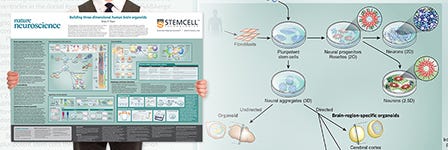How to Dissociate 3D Neural Organoids into a Single-Cell Suspension
Reflective of their organized 3D cytoarchitecture, neural organoids contain diverse cell types, including neurons, neural progenitors, radial glia, astrocytes, and oligodendrocytes. Single-cell methods such as single-cell RNA sequencing or flow cytometry have been increasingly employed to better characterize and understand these distinct cell types. An important first step in any single-cell analysis is the generation of a highly viable cell suspension. The following protocol describes single-cell dissociation of brain organoids between 25- and 100-days-old using enzymatic dissociation with papain, and was adapted from previously published protocols1,2,3.
Materials
- Papain, 100 mg (Catalog #07466)
- DNase I Solution (1 mg/mL) (Catalog #07900)
- Hanks’ Balanced Salt Solution (HBSS) with 10 mM HEPES, Without Phenol Red (Catalog #37150)
- Ovomucoid protease inhibitor (e.g. Worthington Catalog #LK003182)
- Papain activation solution (1.1 mM EDTA, 0.067 mM mercaptoethanol, 5.5 mM L-cysteine HCl)
- 37 μm Reversible Strainers (Catalog #27250)
- Hemocytometer (e.g. Hausser Scientific™ Bright-Line Hemocytometer, Catalog #100-1181)
- Trypan Blue (e.g. Catalog #07050)
*Protocol is tested for compatibility with organoids generated with STEMdiff™ Cerebral Organoid Kit (Catalog #08571), STEMdiff™ Dorsal Forebrain Organoid Differentiation Kit (Catalog #08620), and STEMdiff™ Ventral Forebrain Organoid Differentiation Kit (Catalog #08630). Optimization may be required for other neural organoid types.
Part I: Preparation of Reagents
- Prepare Papain Stock Solution
a. Reconstitute 100 mg papain in filter-sterilized activation solution (1.1 mM EDTA, 0.067 mM mercaptoethanol, 5.5 mM L-cysteine HCl) to a stock concentration of 250 units/mL. Calculate the appropriate reconstitution volume by taking into account the lot-specific % protein and activity.
Refer to the example below.Example Calculation:
Lyophilized papain powder (Catalog #07466) will activate to at least 15 units/mg protein. For the lot-specific activity value and % protein, please refer to the Certificate of Analysis (CoA), which can be retrieved from the STEMCELL Technologies website at www.stemcell.com/coa.
Example activity on CoA = 18.0 units/mg protein (units/mgP)
Example % protein on CoA = 75%
Desired concentration = 250 units/mL
b. Mix solution well without generating bubbles.
c. Incubate the solution at 37°C for 30 minutes to activate the enzyme.
d. Store activated liquid suspension at 2 - 8°C for up to 2 weeks. Do not freeze.
- Prepare Dissociation Solution (immediately before use)
a. Dilute the papain stock solution (prepared in step 1) and DNase I Solution in HBSS to the following concentrations:
i. 30 units/mL papain
ii. 125 units/mL DNase I
Refer to the example below.Example Calculation:
DNase I Solution (Catalog #07900) is provided with an activity range of ≥ 2000 units per mg of protein. Thus, the starting concentration of DNase I may be assumed to be 2000 units/mL for the purposes of these calculations.
To prepare 10 mL of dissociation solution:
- Add 8.175 mL of HBSS to a 15 mL conical tube.
- Add 1.2 mL of papain stock solution (250 units/mL) to the tube.
- Add 0.625 mL of DNase I Solution (2000 units/mL) to the tube.
-
Prepare Ovomucoid Protease Inhibitor Solution
a. Reconstitute ovomucoid protease inhibitor to 10 mg/mL in HBSS.
b. Filter-sterilize if desired.
c. Store the solution at 2 - 8°C for up to 1 week.
Part II: Neural Organoid Dissociation
- Transfer one neural organoid into each well of a 24-well plate containing 0.5 - 1 mL of either DMEM/F-12, PBS, or HBSS.
- Aspirate the DMEM/F-12, PBS, or HBSS from each well and replace it with 500 μL of dissociation solution (freshly prepared in Part I) into each well.
- Incubate at 37°C for 30 minutes on an orbital shaker set to 90 rpm or higher.
Note: A longer incubation may be required for organoids that are older than 100 days. Other parameters that may need optimization for older organoids include the type of dissociation reagent used, temperature of dissociation, and mechanical manipulation of the tissue.
- Using a 1 mL pipettor, triturate 5 - 6 times at room temperature (15 - 25°C) to obtain a suspension consisting primarily of cell aggregates.
- Incubate at 37°C for 10 minutes on an orbital shaker set to 90 rpm or higher.
- Using a 1 mL pipettor, triturate 5 - 6 times at room temperature to obtain a suspension consisting primarily of single cells.
- Add the entire cell suspension to a 15 mL centrifuge tube containing 1 - 2 mL of 10 mg/mL ovomucoid protease inhibitor solution (prepared in Part I).
- Centrifuge the tube at 300 x g for 5 minutes.
- Remove the supernatant, resuspend cells in appropriate buffer (e.g. HBSS or FACS buffer) and perform a viable cell count using trypan blue and a hemocytometer.
Note: For a day 50 organoid, expected viability is > 95% and expected yield is > 1,000,000 viable cells per organoid with < 5% of cells found in small aggregates.
- To remove remaining cell aggregates, pass the cell suspension through a 37 μm strainer and retain the flow-through.
- Perform a second viable cell count on the flow-through to ensure that any aggregates have been removed and to accurately determine the final cell concentration.
- The resulting single-cell suspension can now be used for downstream applications such as single-cell RNA-sequencing or antibody labeling for flow cytometry.
References
- Kanton S et al. (2019) Organoid single-cell genomic atlas uncovers human-specific features of brain development. Nature 574(7778): 418–22.
- Velasco S et al. (2019) Individual brain organoids reproducibly form cell diversity of the human cerebral cortex. Nature 570(7762): 523–7.
- Yoon SJ et al. (2019) Reliability of human cortical organoid generation. Nat Methods 16(1): 75–8.
Request Pricing
Thank you for your interest in this product. Please provide us with your contact information and your local representative will contact you with a customized quote. Where appropriate, they can also assist you with a(n):
Estimated delivery time for your area
Product sample or exclusive offer
In-lab demonstration




